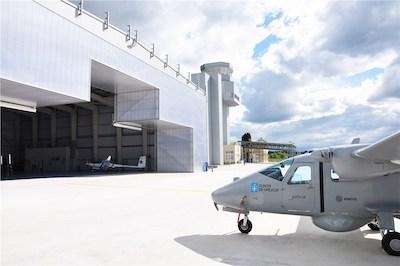Simulated Flight Tests Are Being Held To Validate The Design Of The Critical Elements Of The OPV
Indra, one of the leading global technology and consulting companies, and its partner Gaerum have just reached a key milestone in the development of the optionally manned Targus aircraft: the start of simulated flight tests to validate the design of the aircraft's critical systems.

Specifically, they have begun studying the flight control, navigation and mission systems at the CIAR (Rozas’ Center for Research and Experimentation) in Castro de Rei (Lugo). All of them are components that play a fundamental role for the safety and operability of the aircraft.
Indra uses an advanced simulation methodology known as Software-In-the-Loop/ Hardware-In-the-Loop that makes aircraft systems “believe” that they are actually in the air.
Engineers test the electronic systems’ behavior in an environment set up to be 100% realistic. This is thanks to the fact that the data that feeds these components have been collected in real flights and perfectly replicate the situations they will face when they operate in a real environment. In this way, the results of the numerical simulations previously performed in the laboratory by the Indra and Gaerum team are fine-tuned.
Design decisions are validated before moving on to the actual flight test phase, which reduces costs and minimizes risks associated with development and experimentation. Once the correlation between the behavior of the system in the simulator and in the air is confirmed with a flight test, all these simulation hours will be regarded as real flight hours.
The deadlines for obtaining authorities’ flight certification are expedited in this way; a complex, demanding and totally unprecedented process for an aircraft with the characteristics of the Targus, which weighs 1.2 tons and has a wingspan of 36 feet. The use of the simulation tool will shorten the time to market and reduce the price at which the product will be marketed, contributing to its success.
Once the tests with these components are completed, the next step will be to integrate them into the experimental aircraft for the development of the Targus. The aircraft will undergo hundreds of hours of simulation to improve the models of the aircraft and all its sensors and actuators. Then, a battery of tests in the simulator will optimize the algorithms of the flight control and navigation system. Once these tests are passed, the flight experimentation stage will be undertaken.
Meanwhile, Indra is already working in parallel on the integration of the ground segment, a system whose role is to operate the aircraft from the ground and control all its mission equipment. These are the ones that collect and send data and images captured by the aircraft from overhead.
The Targus is an optionally manned aircraft developed by Indra as part of the Civil UAVs Initiative promoted by the Xunta de Galicia. The Targus is equipped with the most advanced surveillance technology to conduct missions related to maritime surveillance; to bring support to salvage and rescue missions, forest surveillance and fire-fighting, and to monitor land use and historical heritage sites, among many other possible applications.
(Image provided with Indra news release)
 ANN's Daily Aero-Term (04.25.24): Airport Rotating Beacon
ANN's Daily Aero-Term (04.25.24): Airport Rotating Beacon ANN's Daily Aero-Linx (04.25.24)
ANN's Daily Aero-Linx (04.25.24) Klyde Morris (04.22.24)
Klyde Morris (04.22.24) Airborne 04.24.24: INTEGRAL E, Elixir USA, M700 RVSM
Airborne 04.24.24: INTEGRAL E, Elixir USA, M700 RVSM Airborne 04.22.24: Rotor X Worsens, Airport Fees 4 FNB?, USMC Drone Pilot
Airborne 04.22.24: Rotor X Worsens, Airport Fees 4 FNB?, USMC Drone Pilot



